Fermented oatmeal is a traditional way to prepare rolled oats. It’s a healthy breakfast option that is as quick as instant oatmeal, but far healthier. Serve with nutritious and probiotic toppings to really kick-start your day!
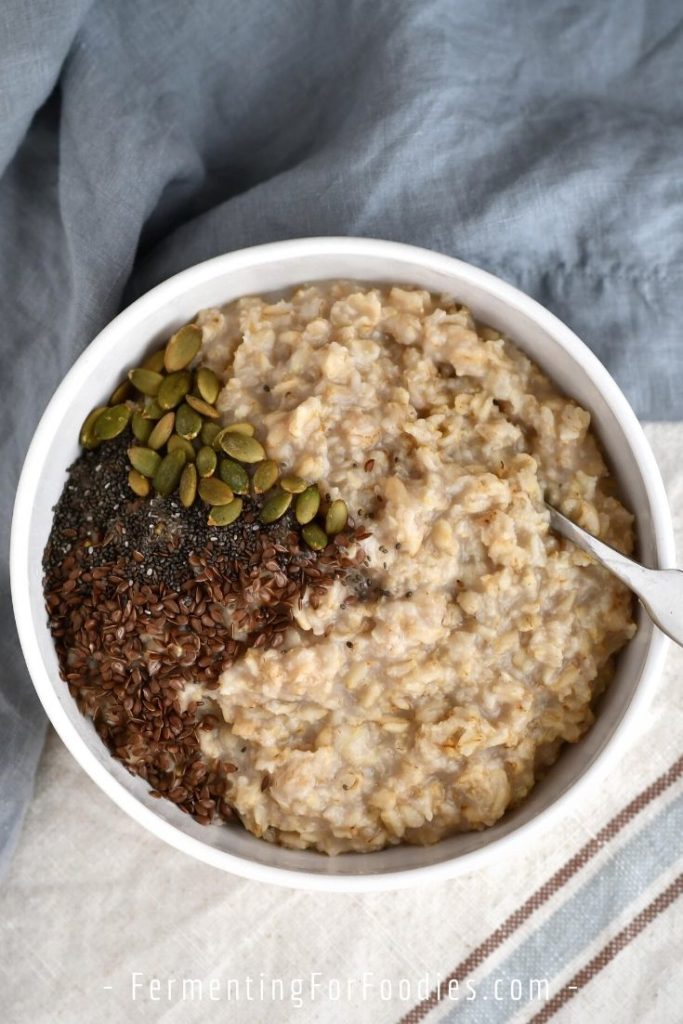
Why Ferment oatmeal?
This recipe is not the same as overnight oats, which are eaten raw. These oats are soaked and fermented before cooking. It’s a traditional way of preparing grains and has a number of benefits.
- Reduced cooking time: Soaked rolled oats will cook in the same amount of time as quick oats.
- Improved digestion: Complex carbs are broken down before cooking allowing for easier digestion and improved nutrient absorption.
- Flavor development: Fermented oatmeal has a delicious sourdough flavor.
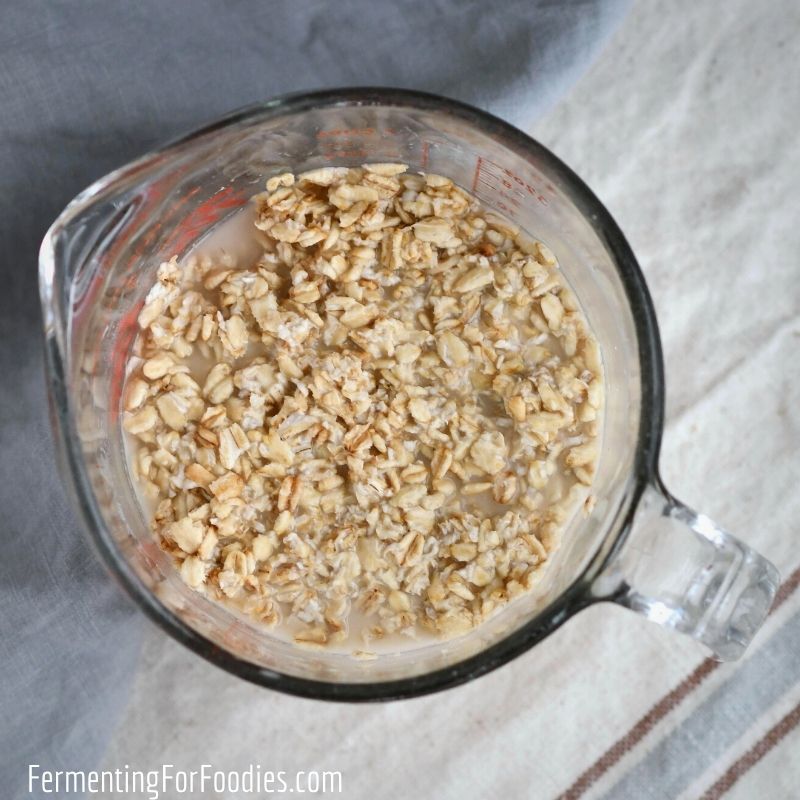
Oatmeal Flavors
It’s easy to add delicious and nutritious flavors to your oatmeal.
- Stir in flax, chia seeds, hemp hearts, or pumpkin seeds.
- Add fresh berries, chopped apples, or raisins.
- Cook your oatmeal with pumpkin pie spice, chai spice, or straight cinnamon.
Probiotic Toppings For Oatmeal
Typically we make plain oatmeal and serve it with a variety of toppings, including a few probiotic options.
- Cultured Coconut Milk: Thick and creamy coconut milk yogurt is delicious with sliced banana, kiwi and pineapple.
- Fruit Sauce and Jam: Try a spoonful of fermented berry sauce with a sprinkling of hemp hearts and cinnamon or a dollop of fruit and chia seed jam.
- Caramel Sauce: If you’re a sweet tooth, switch up your usual sweet toppings for a probiotic caramel date sauce.
- Naturally Sweet Condiments: Instead of jam, try a naturally sweet fermented condiment, like this spiced apple spread.
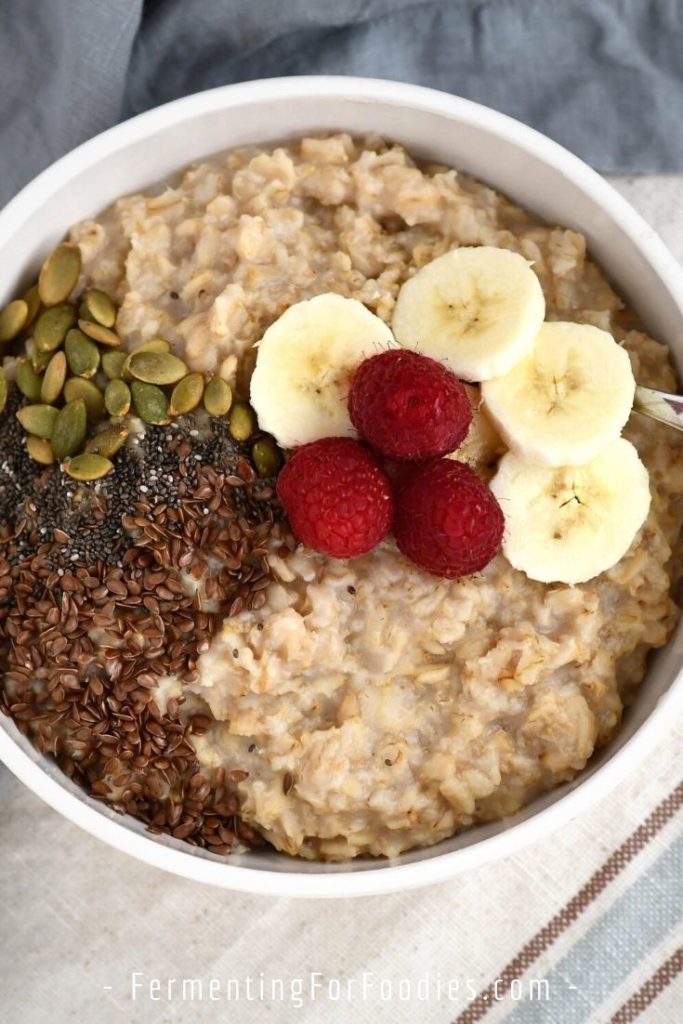
Soaked and Fermented Oatmeal
Does breakfast leave you feeling sluggish and full? Try making soaked and fermented oatmeal for a quick and easy breakfast. It’s the perfect way to start your day!
- Prep Time: 2 minutes
- Cook Time: 10 minutes
- Total Time: 12 minutes
- Yield: 2 servings 1x
- Category: Breakfast
- Method: Fermented
- Cuisine: Traditional
- Diet: Gluten Free
Ingredients
- 1 cup rolled oats
- 4 Tbsp culture (see notes for options)
- 3/4 cup water for soaking (chlorine-free)
- 1 cup of water for cooking
Instructions
- Mix the oats with the culture and 3/4 cup of water in a glass bowl or measuring cup. Cover with a tea towel and leave it to ferment in a warm location for up to 24 hours. We usually set up our oatmeal right before bed.
- Oats can be eaten raw, like soaked muesli. They will retain their probiotic benefits. However, I don’t recommend uncooked oatmeal for anyone who has issues with digesting grain.
- To cook, mix the soaked oatmeal with 1 cup of water. Bring to a boil in the microwave or on the stovetop. Give it a good stir, then turn off the heat. The oats should be cooked within a few minutes.
Notes
- Usually, I make fermented oatmeal with milk kefir. You could also use other dairy cultures like buttermilk and yogurt.
- For vegan oatmeal, culture with vegan yogurt, kombucha, or raw apple cider vinegar.
- To make sourdough oats, simply mix 1 cup of oats with 1 cup of water. Stir daily, and they should start to sour within 5 to 7 days. Unlike some other grains, store-bought oats don’t have a wild-yeast culture, so it can take a while to get them sourdough fermenting.
Nutrition
- Serving Size: 1 cup oatmeal (dairy culture)
- Calories: 332
- Sugar: 3g
- Sodium: 26mg
- Fat: 5.7g
- Saturated Fat: 1.2g
- Carbohydrates: 57.6g
- Fiber: 8.3g
- Protein: 12.5g
- Cholesterol: 2mg
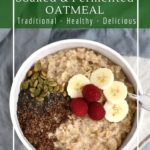
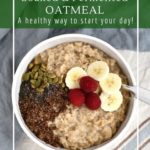
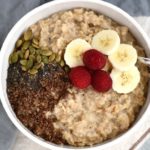
Emillie, does one have to use a starter culture? Will the oats ferment on their own without the inclusion of any culture?
Oats will fermented without a starter (like sourdough), however it will probably take about 5 days. I usually set up my oatmeal the night before with a starter because I’m not that organized!
I put the leftovers of my oat milk making in a jar and they’ve gone all bubbly like a sourdough starter and smell pretty fermented.
Originally I wanted to turn it into cookies, but it’s been a few days – is it still okay to eat?
There’s a chance you caught a sourdough starter, especially if you already make other ferments in your home. If you aren’t certain, then I don’t recommend eating it. Always better to be cautious!
However, if you know what sourdough starter smells like and looks like, then you should be able to tell if it seems like a healthy sourdough culture. Good luck!
I put organic yogurt & the liquid with my oats & water overnight and eat them straight out of the jar (not cooking) is that okay? Especially in summer time, I’d rather not cook them. Is it more or less beneficial cooking or eating raw. I add blueberries, nuts, seeds and a little almond creamer to sweeten. Just wondering what you opinion is about eating them ‘raw’
Fermenting the oats for raw eating is definitely better than just eating raw oats with milk (muesli style.) If it doesn’t bother you, then I don’t think you need to have it cooked, especially as having it raw will give you a good dose of probiotics.
I did to .I like to eat with 2 boiled eggs , berries and nut
Sounds yum!
Can I use sheep’s or goats yogurt as the culture. Normally I have soaked my oats with apple cider vinegar or lemon juice but never yogurt ….and also I do not have to rinse them right ? I totally forgot about eating soaked oats…..so good for gut….
Yes! I love sheep’s yogurt! And you won’t have to rinse them after soaking. Enjoy!
There are vegan kefirs out there nowadays, too – for example GT’s makes a few different flavors of it, from coconut water.
I’ll have to look into those. I haven’t seen vegan kefir before (besides water kefir). Cheers!
Love the sound of this. Just wanted to check / I should be using kefir milk not the grains?
The grains only like to culture in milk. So use cultured milk kefir in this recipe. It has enough bacteria/yeast to culture the oatmeal. Yum!
Thank you for the quick reply. Can’t wait to try this 🙂
Is there any worry about this having alcohol in it? If eaten cold like overnight oats.
All yeast based ferments (kombucha, kefir, bread) make some alcohol. Yeast converts sugar into alcohol and CO2. However, unless you’re using high alcohol strains (specific for wine and beer) it won’t get above 0.5%.
If you are still concerned, soak your oats in yogurt, which is not a yeast based ferment. Enjoy!
My inquiry is similar to Haddie’s. I wonder if cooking the oats kills the probiotics. The benefit still remains that its removed the indigestible part. Maybe cooking them no higher than medium heat is better? I didn’t boil mine since they were sticking to the bottom and evaporating pretty quickly.
This is a cooked oatmeal, which means it’s not probiotic. However, eating soaked oats without cooking would be probiotic. I mostly ferment them cook to improve the digestibility. To avoid killing the probiotics you could heat the oats to 40 C, 104 F. But that is really barely above room temperature. 🙂
You can create a sourdough oat starter just like any other sourdough starter. This is really quick and easy if you already have a sourdough starter: just mix a little of that with oats and water and proceed as usual. If you don’t have a sourdough starter, you can start to create one using any raw whole grain and then switch to rolled oats after a day or two. Rolled oats aren’t the best for the initial mix because they’re steamed in processing, which kills the organisms you need. To eat raw, you’ll want to have switched to rolled oats for several days before using. To eat cooked, you can actually just use your wheat/rye/whatever starter directly.
For this technique, overnight at moderate to cool room temperature works best.
Nice! I haven’t tried the “perpetually fermented oatmeal” method, because my family really prefers my fermented granola to oatmeal. But I love oatmeal and would love to try this out sometime. Thanks for sharing!
Thank you for the great recipe.
This is so interesting! I haven’t eaten oats in a long time because they’re high in arginine and give me a cold sore when I do eat them. I heard that fermented oats are much lower in arginine, so I’d like to try this but I am also eating dairy free. In this case, I can just use any type of kombucha and the oats and it will work? Thanks!
Yes! Flavours might be a nice addition. My only recommendation is if you’re using store-bought kombucha, then aim for something that’s locally made. The mass-produced kombucha doesn’t contain alive yeast (or it wouldn’t be shelf-stable and able to ship.) I hope it works for you. I also have issues with cold sores and eat soaked oats most days without issue.
Cheers, Emillie
I have read elsewhere that to make the oat yoghurt more quickly next time, you could save some to use as a starter. It is not further detailed how to do this and I was wondering what your take on this might be and if you could give a description on how to do this exactly.
I’m new to this and in general not too experienced in the kitchen so would really appreciate the help.
Thanks for a great recipe and tips on interesting probiotics to top it with too!
You can always kickstart a new ferment with a little bit of the last batch. Save 2 tbsp of your previous ferment and add it to your next batch. The only trick is to re-culture about once a week to keep the culture strong and active. Good luck!
Hi there!
Should I be rinsing the oats before cooking, particularly if I’m fermenting for as much as 2 days? Also, I didn’t realize that a 1 to 1 ratio of oatmeal to water was called for. Is there a reason not to add more water? Finally, you don’t mention adding any high-phytase flour which is supposed to break down the phytic acid in oatmeal, and I’m wondering what your thoughts are on that.
I’m looking for maximum digestibility for my oatmeal because it seems to be the only grain I can eat right now without developing auto-immune symptoms, and I don’t want to lose that option. So I appreciate your reading!!
Thank you!
Hi Katherine, I totally went through that too! Fermented oats were the only grain I tolerated for a number of years (thankfully getting better now with improved microbiome health). And most of the baked goods on this site (unless otherwise specified) are made with oat flour. 🙂
Now to answer your questions: 1. I typically don’t rinse my oats, I just ferment them then cook with the fermenting liquid. 2. The amount of water really depends on how thick or thin you want your oatmeal. Feel free to use more water if you want. 3. You could add a high-phytase flour, however, if you don’t tolerate other grains then I don’t recommend it. Especially as most high-phytase grains contain gluten and buckwheat is hard to digest. Another option is to buy whole oats and sprout them prior to grinding and fermenting. Oatmeal is really forgiving. Feel free to try a few different fermentation options and see what works best for you! One more thought, oatmeal is often milled with a bit of wheat to make the final cereal more creamy. If you’re gluten-sensitive, then you may want to invest in GF oats.
Be well!
So without reading the comments first, I just simply soaked my steal cut oats overnight on the counter, then rinsed them in the morning and then, to achieve the fermenting process, I just poured milk kefir (no water added) over these oats and I left this again on the counter today all day and now, in the evening, because my kitchen is pretty cold, I put the pot with the lid (which has a hole in it for steam escape), inside of my turned off oven, but turned the light on (this trick is used by many sourdough bakers btw). I am now really curious how my oats turn out tomorrow morning. What do you think Emillie?? Is it going to be edible and still healthy? Should write another comment about the experience, would anyone want to know what happened? Let me know 🙂
Are you planning on eating the oats cold or cooked? Either way, I think it should work! Especially if the steel cut oats soften with the soaking. It would be great if you could share the results! I’m always updating posts (as I find the time) and it would be handy to include info about steel cut oats. 🙂
Could I rinse the oats after they have fermented, before I cook them? Any potential downside?
Thanks!
I haven’t done that… the only issue that I can see is that fermenting makes the oats quite soft. Not exactly sure how easy it would be to rinse them.
I do not see any signs of fermentation after 24 hours. What should we see that indicates it is fermenting?
Hi Kyle, Because rolled oats are quite large, you won’t see bubbles. However, if you used kefir and filtered water, then it should have fermented! Check by smelling the oats and tasting them. They should smell and taste sour. Enjoy!
I tried Kefir with filtered water, but I do not see signs of oat fermentation.
Thanks for this! Do you think I could make this recipe with milk or a milk alternative instead of water? Or is water necessary? Can milk be left on the counter overnight? Thanks!
If you want to use milk instead of water, perhaps use cultured milk for your starter? Kefir, yogurt or cultured buttermilk will all work! You could probably do 1/4 cup of cultured milk with 3/4 cup milk and it will culture with the oatmeal. Enjoy!
Been trying this by milking my oat groats in a mini processor (I get a lot of oat flour and some pieces left whole). It seems to take 3-4 days in our semi cool apartment to begin bubbling. I was wondering if anyone has tried this with steel cut oats? Would it actually ferment and work? Or would it just get all mushy? I’ve been taking my fermented oat culture and stirring it into thick rolled oats with equal amount of oat milk or unsweetened soy milk and letting that soak in the fridge for a day or two before adding it to a pan with water and letting it warm gently. Very porridge-like. Very satisfying as well!
If anyone has tried the steel cut oats, I’d love to hear you success/failure stories. Since I don’t have a mill to crack the whole oat groats, I’m not sure I’m getting enough inside area exposed using my mini processor without turning the bulk of it into flour. Thoughts anyone?
*that’s MILLING my oats, not MILKING
*smh*
Hi David,
I haven’t tried fermenting steel-cut oats (or whole groats). I have tried fermenting other whole grains. Buckwheat softens nicely, but quinoa just sprouts! I suspect that your slightly chopped oats will probably ferment. However, it might take 2 to 3 days to really soften. If you try it, let me know how it goes! Thanks, Emillie
Would apple cider vinegar (with the “mother”) work for this?
Yes! I haven’t tried it, though I’ve used ACV in a lot of different ferments. I imagine the flavour will probably be a bit unusual. Let me know how it works!
Great! I’ll keep you posted.
Do you think 24 hours on the counter is adequate? Or would even 36 or more benefit?
I guess it depends on what you’re looking for in your fermentation. I find 12 hours usually has the oats pretty broken down. But longer would increase the culturing for sure! Just be sure to stir it once or twice during that time.
Yes the flavour is not the best!
Hello, I poured some rolled oats and rolled spelt into my container with some apple cider vinegar and water. Then I saw some dark specks , and I tried to investigate, but couldn’t tell if they were burnt specks, other grain that got mixed in, or bugs. So, now I am wondering if it safe to eat. My thought is, that fermenting it a day or two, and then cooking it, will make it fairly safe?
Hi Chelsea,
It’s hard to say what the black specs are… however, it’s totally fine to ferment anyway. Likely it’s flecks of grain husk or something. Cheers, Emillie
Hello! I tried this and it turned out great. Fermented coconut milk mixed with my oats and it was wonderful after two days.
Then I tried again and did the same exact thing but this time it had mold on the top. Any reason you know that would happen? It was a bummer to see but I will try again. I’d love feedback. Thanks!
That is disappointing! Do you happen to have mold issues in your home (like in the walls, floor, ceiling)? That increases the likelihood that ferments will go moldy. Two things to try: 1. Make sure you stir every day so that the oats are all evenly cultured. 2. Since you’re using a culture (not wild-fermented sourdough) you can ferment in a closed container. If your coconut milk contains a yeast-based culture, then you’ll need to use a jar that can handle carbonation, and be sure to release the pressure daily. If it’s coconut yogurt, then you don’t have to worry about that. Good luck!
Thank you, I will try again with your recommendations. Thank you!
Thanks for the info about wheat added to make creamy oats! Won’t be using those. I have been soaking rolled oats overnight for me and the dog for years and eating them uncooked. Found adding Apple cider vinegar an easy way to consume the latter but just soaked with yoghurt is the best way for us.
Thanks for sharing!
Hi, I put my oats with water and yoghurt culture to yoghurt maker at 42C for 12 hours. Eat next day. Anyone tried to do the same?
I haven’t done that with oats, but I have done that with rice (for rice pudding). However, I love the idea of yogurt-cultured overnight oats. I’ll have to try it this winter. Yum!
For sourdough oats how do you know if the oats are fermenting or have gone rotten? I’ve never made sourdough before so I’m not sure what it should smell like! My husband thinks it smells rotten though
It should smell pleasantly sour, but not rotten. Hum… I’ve never smelled bad sourdough. However, the few times I’ve had it go off, it changed color or went moldy. Watch out for a black or pink hue. Good luck!
Hi ,
I ground the oats into a coarse powder.
Added some water and two spoons of kefir. Left it overnight in a closed container, After 12 hours, it has a mildly sour kefir smell, but it is a little sticky, it forms thin strands, is that normal?
Thanks,
Rahul
Hi Rahul, It sounds fairly normal. Oats are quite sticky with fermenting. The thin strands are likely due to your kefir culture. (Some types of kefir has that as part of its yeast structure.) If it smells like kefir then it’s ready. Enjoy!
Thanks Emily, it came out good. It was my first time trying to ferment something, so I was not sure.
Thanks,
Rahul
Congrats on your first ferment!
Thanks Emillie, I plan to make the ginger ferment drink, how do I know it has not converted to vinegar?
Thanks,
Rahul
Hi Rahul, I have never had ginger beer turn to vinegar. It will naturally sour as it ferments, but it shouldn’t turn to vinegar unless you leave it to ferment at room temperature for more than 3-4 weeks. Even then, I really haven’t had an issue. If your ginger bug tastes too sour, then perhaps try feeding it a bit more sugar. Cheers!
Thanks Emillie, since I visited your site I have been very fascinated by the art of fermentation and creating all these fancy things. Just being a little cautious as I learn.
As always thanks for your responses.
Thanks,
Rahul
Btw can I use honey instead of sugar? I like it more…
Thanks,
Rahul
Ginger bug is fed on sucrose, so it needs to be fed sugar. Raw honey has its own culture and will ferment when diluted. I have a few honey-fermented beverages on my blog. They are very quick as raw honey naturally ferments well. Perhaps this recipe is more what you are looking for? https://www.fermentingforfoodies.com/health-tonic/ Cheers, Emillie
Hello Emillie. Just strated doing fermenting my oatmeal last night but I wasn’t sure If I am doing it correctly. I put 1/4 of whole grain rolled oats, 1/2 almond milk, korean probiotic powder, pinch of salt and pumpkin seeds. But my question is would it be okay to add 1 Tbps of sugar in the raw before fermenting or after ? I feel like eating my oatmeal with little touch of sweetness. Thank you !:)
Hi! It’s totally fine to add a bit of sugar. Depending on the culture, it may feed the ferment and end up less sweet than you expect. If that happens, you can always add a bit more sugar when you’re eating it. Enjoy!
its so simple, KISS, oats, fresh water, mixed them together, cover in a bowl, each day, stir for 10 seconds, at about day 4-5 you can smell the sour, yeast and see the bubbles. no need to add anything, nature just does it all, its alive, its fermenting. each day, extract what you need to eat, then replace the volume of dry oats, add some water, stir and walk away. not sure why peeps want to add starters
Hi Silvio, There are lots of ways to ferment. It’s one of the joys of fermenting! The option for sourdough oats (as you’ve described it) is in the notes section of the recipe. It’s also the version I chose to include in my cookbook. However, fermenting oats with culture is quick and easy! Perfect if you want to eat fermented once in a while, but aren’t interested in maintaining a sourdough oat culture. I enjoy fermenting with different cultures because they provide different flavor options. Buttermilk cultured oats taste different from ACV cultured oats or sourdough oats. Cheers! Emillie
this was fantastic! i’ve been hesitant to leave something like milk kefir out over night but WOW. i have been missing out for such a silly worry. this will be on repeat in our house, thank you!
I’m glad you enjoyed it! I use milk kefir for so soaking and fermenting many things… 🙂
Can you use water kefir grains or sourdough culture?
Water kefir and sourdough can both be used to culture oats! I wouldn’t use water kefir grains, but rather the unflavored liquid. Oats are also perfect for sourdough. In fact, I included a sourdough oatmeal recipe in my cookbook! Cheers, Emillie
My way to go: Oat flakes (50 g) + kefir (100 g) + raisins (+ maybe some nuts) and then add just enough water to have kinda thick dough in the morning. Then I leave it overnight on the counter to ferment. And in the morning? I throw it on a pancake pan and make four awesome thick tasty pancakes!
Yum! I love the pancake oatmeal option. Definitely going to try that sometime soon.
I’m curious why not add water for cooking while it’s fermenting so it stays submerged and doesn’t develop mold?
This is a short ferment, so keeping it underwater isn’t necessary. However, you could add it if you want. I just find it easier to soak a smaller amount. In my cookbook, I have a sourdough oatmeal recipe, which actually needs air to catch the culture. Cheers!
I do a overnight fermented mish mash that includes oatmeal and ground nuts and seeds like flax, walnuts, pumpkin etc. I only do 3 tbsp oatmeal so that a variety of other stuff can be added without overfilling. As they say, variety is the spice of life.
Yum! Thanks for sharing.
Just a question. I’ve been making overnight oats just by adding almond milk and putting it straight into the fridge right away. Does that cause fermentation of the oats, even if left in there for multiple days? Thanks
Oats are nearly always heat-processed. (Otherwise, they have some pretty bitter-tasting cultures. Based on personal experience, I don’t recommend truly raw oats).
So adding almond milk won’t cause the oats to ferment. However, if you use almond milk yogurt, the culture in the yogurt will help ferment the oats. That will happen more quickly at room temperature, but it will still happen in the fridge.
Cheers! Emillie
Would it be ok to just use sourdough starter and ferment overnight? Also could you eat them raw with the sourdough starter in it? I’ve read different thoughts on that so just curious your opinion
The sourdough culture, itself is fine to eat raw. However, grain digests better when it is cooked. Even fermented grain is easier to digest when cooked. So, while it is perfectly safe to eat, I wouldn’t personally eat raw sourdough starter. Cheers, Emillie
Oh that definitely makes sense! Thank you so much for the quick reply
Emily, do you cover the container during the 24 hours? I was under the impression that heating fermented foods destroys the fermenting nutrients. So what would be the point of soaking the oats in the Kiefer or other fermenting ingredients?
Or is the purpose of soaking just to make them more digestible, which would be a win win for me?
Thank you so much for adding to our health.
Hi Judy, I just it with a tea towel to keep out fruit flies (and cats at my house). Cooking will kill the probiotics. However, you could eat this like overnight oats if you prefer! I have quite a bit of difficulty digesting grain, so I often pre-ferment grain before cooking. (Like these oats, or sourdough bread). Enjoy! Emillie